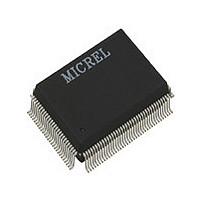KSZ8995XA B3 Micrel Inc, KSZ8995XA B3 Datasheet - Page 26

KSZ8995XA B3
Manufacturer Part Number
KSZ8995XA B3
Description
Manufacturer
Micrel Inc
Datasheet
1.KSZ8995XA_B3.pdf
(55 pages)
Specifications of KSZ8995XA B3
Number Of Primary Switch Ports
5
Internal Memory Buffer Size
64
Operating Supply Voltage (typ)
1.8/2.5/3.3V
Fiber Support
Yes
Integrated Led Drivers
Yes
Phy/transceiver Interface
MII/SNI
Power Supply Type
Analog/Digital
Package Type
PQFP
Data Rate (typ)
10/100Mbps
Vlan Support
Yes
Operating Temperature (max)
70C
Operating Temperature (min)
0C
Pin Count
128
Mounting
Surface Mount
Jtag Support
No
Operating Temperature Classification
Commercial
Lead Free Status / RoHS Status
Compliant
September 2008
SNI Interface Operation
The serial network interface (SNI) is compatible with some controllers used for network layer protocol processing.
This interface can be directly connected to these types of devices. The signals are divided into two groups, one for
transmission and the other for reception. The signals involved are described in the table below.
This interface is a bit-wide data interface and therefore runs at the network bit rate (not encoded). An additional
signal on the transmit side indicates when data is valid. Likewise, the receive side has an indicator that conveys
when the data is valid.
For half-duplex operation there is a signal that indicates a collision has occurred during transmission.
Advanced Functionality
QoS Support
The KS8995XA is a QoS switch, meaning that is it able to identify selected packets on its ingress ports, prioritize
them, and service the packets according to their priority on the egress ports. In this way, the KS8995XA can provide
statistically better service to the high priority packets that are latency sensitive, or require higher bandwidth. The
KS8995XA supports ingress QoS classification using three different mechanisms: port-based priority, 802.1p tag-
based priority, and DSCP priority for IPv4 packets.
Port-based priority is useful when the user wants to give a device on a given port high priority. For example in Figure
7, port 1 is given high priority because it is connected to an IP phone and port 4 is given lower priority because it is
connected to a computer whose data traffic may be less sensitive to network congestion. Each port on the
KS8995XA can be set as high or low priority with an EEPROM. The port priority is set in bit 4 of registers 0x10, 0x20,
0x30, 0x40, 0x50 for ports 1, 2, 3, 4 and 5, respectively. Port-based priority is overridden by the OR’ed result of the
802.1p and DSCP priorities if they are all enabled at the same time.
SNI Signal
TXEN
COL
CRS
RXD
RXC
TXD
TXC
Figure 7. Port-Based Priority
Serial Transmit Data
Serial Receive Data
Collision Detection
Table 3. SNI Signals
Transmit Enable
Transmit Clock
Receive Clock
Carrier Sense
Description
IP Phone
26
KS8995XA Signal
SMRXD[0]
SMTXD[0]
SMTXEN
SMRXDV
SMRXC
SMTXC
SCOL
M9999-091508













